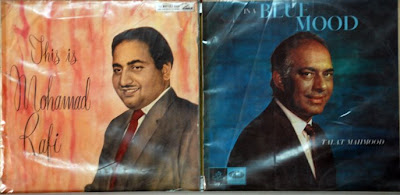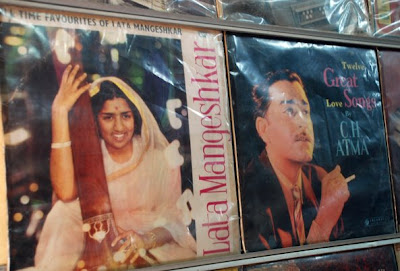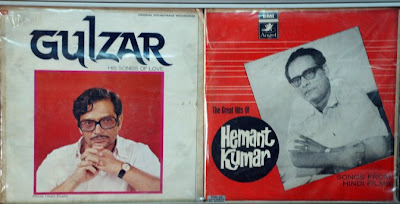In 1877 the U.S. inventor Thomas Alva Edison heard “Mary had a little lamb” emanate from a machine into which he had just spoken the ditty. Thomas Edison ran a paraffin coated paper under a stylus while shouting into a telephone speaker, the vibrations left a faint impression of his voice which could be played back. It was the first time a recording of the human voice had been reproduced, and the event signalled the birth of the phonograph. By the end of the 19th century the invention took the shape of the gramophone which soon became popular as a medium of entertainment.
been reproduced, and the event signalled the birth of the phonograph. By the end of the 19th century the invention took the shape of the gramophone which soon became popular as a medium of entertainment.
Year 1928. Sayed Ahmed Shah, who had learnt the skill of repairing gramophones used to repair the faulty gramophones at the Mazar Hare-Bhare near Jama Masjid. Many Britishers and Indians from the elite class left their faulty gramophones with him for repairs. Listening to the songs, day in and day out, while repairing the machines, Sayed Ahmed Shah became fond of music and songs and soon started collecting records. The interest of collecting records was  sparked to a bigger magnitude when qawwalis of Bibi Dholki and Kallan Khan were released on vinyl in 1930. Over the years Ahmed Shah’s interest turned to film music and he began buying records of K.L. Saigal, Noorjehan, Millika Pukhraj and other great singers of that era.
sparked to a bigger magnitude when qawwalis of Bibi Dholki and Kallan Khan were released on vinyl in 1930. Over the years Ahmed Shah’s interest turned to film music and he began buying records of K.L. Saigal, Noorjehan, Millika Pukhraj and other great singers of that era. He would buy two copies of each release – one for his collection and the other for his listening pleasure. Ahmed Shah earned such a fame during his life time that leading music companies producing 78 rpm vinyl records like HMV, Young India, New Theatres, Lahore Music Company used to consult him on the kind of records that should be released. Amazingly, he could almost accurately predict the number of copies a record would sell by listening to it for a day or two.
He would buy two copies of each release – one for his collection and the other for his listening pleasure. Ahmed Shah earned such a fame during his life time that leading music companies producing 78 rpm vinyl records like HMV, Young India, New Theatres, Lahore Music Company used to consult him on the kind of records that should be released. Amazingly, he could almost accurately predict the number of copies a record would sell by listening to it for a day or two.
At the time of his death in 1977, Ahmed Shah had possessed a formidable collection of records. The baton was passed on to the son, Akbar Shah, who proved to be a worthy inheritor of the legacy. He further added to the huge collection by picking up records from private collectors, old curio shops and even junk markets. Akbar Shah narrates an interesting incident when he was searching for a particular song. The long search turned futile and Akbar Shah gave up. Then once while rummaging through the records at a ‘kabadi’ (junk) market in Hyderabad, he struck gold. The record which Akbar Shah thought that no longer existed was found in the junk. The song was from the 1954 film, “Shaan-e-Haatim” and contained Mohammad Rafi’s soulful rendering of, “Sabak Raza Ka De Gaye, Karbale Wale”. No just this. The collection includes Suriya’s songs from her first film, Natak; Naushad’s first film, Prem Nagar; O.P. Nayyar’s first film, Aasmaan; Ravi’s first film, Vachan; Dilip Kumar’s first film, Jwar Bhata and Raj Kapoor – Madhubala starrer, Neel Kamal. Besides he has practically all the non-filmy songs of Mohd. Rafi, Mukesh, Talat Mehmood, Lata Mangeshkar, Usha Mangeshkar and Asha Bhonsle.
Rafi, Mukesh, Talat Mehmood, Lata Mangeshkar, Usha Mangeshkar and Asha Bhonsle. The qawwali collection has works of great Qawwals of yore like Habib Painter, Mumtaz Shabbir, Ismail Azad, Kalwa Banne, Abdur Rahman Kanchawala, Kallan Khan Secunderabadi to name a few.
The qawwali collection has works of great Qawwals of yore like Habib Painter, Mumtaz Shabbir, Ismail Azad, Kalwa Banne, Abdur Rahman Kanchawala, Kallan Khan Secunderabadi to name a few.  Among the Ghazals collection he has the records of Begum Akhtar, Mallika Pukhraj, Kamla Jharia, Kanan Devi and songs sung by actresses like Shanta Apte and Naseem Banu. Apart from adding to the collection, Akbar Shah systematically catalogued the collection of records and the system of cataloging too is unique in itself. Songs and records which are easily available are put in the category ‘chalu’. Those which have gone out of circulation are put in the category ‘cancelled’. And those which belong to the pre-partition (before 1947) era are categorised as ‘Khandani’.
Among the Ghazals collection he has the records of Begum Akhtar, Mallika Pukhraj, Kamla Jharia, Kanan Devi and songs sung by actresses like Shanta Apte and Naseem Banu. Apart from adding to the collection, Akbar Shah systematically catalogued the collection of records and the system of cataloging too is unique in itself. Songs and records which are easily available are put in the category ‘chalu’. Those which have gone out of circulation are put in the category ‘cancelled’. And those which belong to the pre-partition (before 1947) era are categorised as ‘Khandani’.  One of the unique features of his collection is the collection of records of songs sung by Mohd. Rafi in twenty different languages. He proudly mentions that he has every single song of Rafi in his collection. He has in his possession songs of some films which even the old timers have not heard of. These include films like ‘Ha Ha Hi Hi Hu Hu’, ‘Tin Tin Tin’, ‘Dr. Z, ‘Dr. Shaitan’, ‘Rocket Girl’, and ‘Rocket Tarzan’ . The songs have been sung by leading singers like Lata Mangeshkar, Asha Bhosle, Mahender Kapoor and Mohammad Rafi. In 1991, the HMV wanted to relaunch the music of some of their old films but found that the records were not available in their archives. They contacted Akbar Shah who helped HMV
One of the unique features of his collection is the collection of records of songs sung by Mohd. Rafi in twenty different languages. He proudly mentions that he has every single song of Rafi in his collection. He has in his possession songs of some films which even the old timers have not heard of. These include films like ‘Ha Ha Hi Hi Hu Hu’, ‘Tin Tin Tin’, ‘Dr. Z, ‘Dr. Shaitan’, ‘Rocket Girl’, and ‘Rocket Tarzan’ . The songs have been sung by leading singers like Lata Mangeshkar, Asha Bhosle, Mahender Kapoor and Mohammad Rafi. In 1991, the HMV wanted to relaunch the music of some of their old films but found that the records were not available in their archives. They contacted Akbar Shah who helped HMV  by lending them the records of ‘Dulhan Ek Raat Ki’, ‘Bahu Beti’, ‘Saanjh aur Savera’, ‘Kaun Apna Kaun Paraya’, ‘Mastana’, ‘Chingari’, ‘Baat Ek Raat Ki’, ‘Punam Ki Raat’, and ‘Akeli Mat Jaiyo’. The HMV gave due credits to Akbar Shah by putting his name on the recordings. Fifty years after his father Sayed Ahmed Shah had set up business, Akbar Shah shifted to Meena Bazaar near Jama Masjid. Meena Bazaar though primarily a spare parts and tools market has a shop No.256 by the name of Shah Music Centre and the Shahs are fondly called as Record Wale Shahenshah !
by lending them the records of ‘Dulhan Ek Raat Ki’, ‘Bahu Beti’, ‘Saanjh aur Savera’, ‘Kaun Apna Kaun Paraya’, ‘Mastana’, ‘Chingari’, ‘Baat Ek Raat Ki’, ‘Punam Ki Raat’, and ‘Akeli Mat Jaiyo’. The HMV gave due credits to Akbar Shah by putting his name on the recordings. Fifty years after his father Sayed Ahmed Shah had set up business, Akbar Shah shifted to Meena Bazaar near Jama Masjid. Meena Bazaar though primarily a spare parts and tools market has a shop No.256 by the name of Shah Music Centre and the Shahs are fondly called as Record Wale Shahenshah !
Akbar Shah too has retired now. And the business has passed over to his son, Sayed Zafar Shah and the love for music has spilled over to the third generation. Zafar Shah too has some interesting anecdotes to narrate. Once he received a feeler that Saira Banu, was searching for the records of ghazals cut by her grandmother Shamshad Bai Dilli Wali (not to be confused with Shamshad Begum). Now, all Zafar knew was that Saira Banu was the daughter of Naseem Banu, the legendary heroine of the the 40s and 50s. He had no clue about Naseem Banu’s mother Shamshad Bai Dilli Wali (also known as Chhamiyan Bai) and that she had cut a record of her ghazals. Zafar was helped by his father Akbar Shah in locating the record and Zafar personally delivered the recording to Dilip Kumar and Saira Banu at their official residence at Lodhi Estate where Dilip Kumar used to reside as Member of the Rajya Sabha. Tears kept flowing from Saira’s eyes on hearing the recording as she had given up the hope of ever listening to her grandmother’s melodious voice.
Once he received a feeler that Saira Banu, was searching for the records of ghazals cut by her grandmother Shamshad Bai Dilli Wali (not to be confused with Shamshad Begum). Now, all Zafar knew was that Saira Banu was the daughter of Naseem Banu, the legendary heroine of the the 40s and 50s. He had no clue about Naseem Banu’s mother Shamshad Bai Dilli Wali (also known as Chhamiyan Bai) and that she had cut a record of her ghazals. Zafar was helped by his father Akbar Shah in locating the record and Zafar personally delivered the recording to Dilip Kumar and Saira Banu at their official residence at Lodhi Estate where Dilip Kumar used to reside as Member of the Rajya Sabha. Tears kept flowing from Saira’s eyes on hearing the recording as she had given up the hope of ever listening to her grandmother’s melodious voice.
Apart from the Hindi songs, Shahs have a variety of collection of English records containing, The Beatles, Elvis Presley, The Ventures and many 78 rpm English records.
Nobody has this kind of collection of records. Zafar Shah adds that if he does not have a record, chances are that no one has it. He possesses records that even All India Raio doesn’t have. In fact if they require an out of circulation record they contact him. For true blue music lovers, Shah Music Centre has acquired a legendary status. Interestingly they are only who still repair old gramophones. This has largely got to do with gramophones becoming antique pieces in elite drawing rooms.
This entry was posted on Tuesday, June 10th, 2008 at 3:08 PM and is filed under Uncategorized. You can follow any responses to this entry through the RSS 2.0 feed. You can leave a response, or trackback from your own site.
What a great post – amazing that such snippets remain hidden- the corporate media would not be that interested..
many thanks Raja ji
It’s amazing to know that there exist such record keepers. Mr. Shah is certainly doing a great job.
Like always it is meticulous, humane and informative. Simply great! Raja
Another great reading. I still remember when I was a child, I used to stand near the changer and watched the discs rotating and soothing music filling the room of our ancestral home in Faisalabad.
wonderful post ..kya baat hai raj sahab..
aapka tahe dil se swagat karta hun.
you are a dedicated person,you have amazing information ,
Gr8 gr8 gr8 work .. mk
fursat mein hamare channel pa padhariyega..mk
http://www.youtube.com/mastkalandr
Some people think they are worth a lot of money just because they have it.